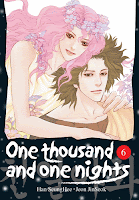My News and Reviews
Although it wasn’t a particularly busy week at Experiments in Manga, I did have three posts in addition to the usual My Week in Manga. November’s Bookshelf Overload was posted over the weekend. There were some really lovely deluxe manga and box sets released in November. The most recent Library Love feature was also posted. I took a quick look at some of the manga that I borrowed from my local library: Black Blizzard, Here Is Greenwood, Nana, and Peace Maker Kurogane. Also, November’s manga giveaway is currently in progress. The winner will be announced on Wednesday, so there’s still time to enter for a chance to win the first four volumes of Harold Sakuishi’s Beck: Mongolian Chop Squad. Simply tell me about your favorite music-themed manga. I also want to mention a marvelous feature on Takehiko Inoue that CNN released as part of its “Human to Hero” feature—How ‘Slam Dunk’ Manga Artist Brings Characters to Life.
Quick Takes
 13th Boy, Volume 1 by SangEun Lee. I’m not entirely sure what to make of 13th Boy, and I have no idea where Lee is taking the story, but I did enjoy the first volume—it was delightfully quirky. The manhwa could have been a fairly straightforward romantic comedy, except for the fact that it incorporates a bit of magic, destiny, and a sentient cactus. (Yes, you read that correctly, a sentient cactus.) Hee-So Eun dated Won-Jun Kang, the boy she fell in love with at first sight, for less than a month before he broke up with her. What she can’t seem to understand is why, and so she’s more determined than ever to prove to him that they should be together. But a mysterious boy in her class, Whie-Young Jang, keeps getting in the way.
13th Boy, Volume 1 by SangEun Lee. I’m not entirely sure what to make of 13th Boy, and I have no idea where Lee is taking the story, but I did enjoy the first volume—it was delightfully quirky. The manhwa could have been a fairly straightforward romantic comedy, except for the fact that it incorporates a bit of magic, destiny, and a sentient cactus. (Yes, you read that correctly, a sentient cactus.) Hee-So Eun dated Won-Jun Kang, the boy she fell in love with at first sight, for less than a month before he broke up with her. What she can’t seem to understand is why, and so she’s more determined than ever to prove to him that they should be together. But a mysterious boy in her class, Whie-Young Jang, keeps getting in the way.
 Finder, Volumes 4-6 by Ayano Yamane. If I understand correctly (and I very well may be wrong), Finder was originally intended to end with the fifth volume, but its popularity was such that Yamane was able to publish more. The sixth volume mostly focuses on Akihito’s everyday life as he tries to get his feet back under him after his traumatic experiences in Japan and Hong Kong’s underworld. It was still a great volume with quite a bit of action, but I did miss the intense, dark drama and complicated character interactions that Fei Long’s presence brought to the previous volumes. The fairly extensive crossover between the Finder series and Yamane’s “In Love” short manga did make me very happy, though.
Finder, Volumes 4-6 by Ayano Yamane. If I understand correctly (and I very well may be wrong), Finder was originally intended to end with the fifth volume, but its popularity was such that Yamane was able to publish more. The sixth volume mostly focuses on Akihito’s everyday life as he tries to get his feet back under him after his traumatic experiences in Japan and Hong Kong’s underworld. It was still a great volume with quite a bit of action, but I did miss the intense, dark drama and complicated character interactions that Fei Long’s presence brought to the previous volumes. The fairly extensive crossover between the Finder series and Yamane’s “In Love” short manga did make me very happy, though.
 Real, Volumes 10-11 by Takehiko Inoue. I honestly believe that Real is one of the best manga series currently being published in English. I first read Real after borrowing the series from the library, but it is such a great series that I had to have a set of my own. I really can’t recommend this series enough. Inoue’s artwork is fantastic and his characters are marvelously complex. The series’ realism is phenomenal. All of the characters are struggling with their own limitations and searching for their place in the world. There are triumphs and there are failures, but how the characters deal with them is what makes the series so compelling, powerful, and even inspiring. I can hardly wait for the next volume.
Real, Volumes 10-11 by Takehiko Inoue. I honestly believe that Real is one of the best manga series currently being published in English. I first read Real after borrowing the series from the library, but it is such a great series that I had to have a set of my own. I really can’t recommend this series enough. Inoue’s artwork is fantastic and his characters are marvelously complex. The series’ realism is phenomenal. All of the characters are struggling with their own limitations and searching for their place in the world. There are triumphs and there are failures, but how the characters deal with them is what makes the series so compelling, powerful, and even inspiring. I can hardly wait for the next volume.
 Reiko the Zombie Shop, Volumes 1-6 by Rei Mikamoto. Action-packed, gory fun is probably the easiest way to describe Reiko the Zombie Shop. It reminds me a bit of Kurosagi Corpse Delivery Service, which is not at all a bad thing; granted Reiko the Zombie Shop was published first. I actually preferred the shorter one-shot stories in the series over the longer more involved plot arcs. Although the longer stories have some advantages: there’s more time to get a feel for the characters (of course, Mikamoto doesn’t hesitate to kill most of them off, anyway), and there’s a wider variety of zombies and powers displayed. Only six of the eleven volumes were released in English, ending on a cliffhanger, but the series is entertaining.
Reiko the Zombie Shop, Volumes 1-6 by Rei Mikamoto. Action-packed, gory fun is probably the easiest way to describe Reiko the Zombie Shop. It reminds me a bit of Kurosagi Corpse Delivery Service, which is not at all a bad thing; granted Reiko the Zombie Shop was published first. I actually preferred the shorter one-shot stories in the series over the longer more involved plot arcs. Although the longer stories have some advantages: there’s more time to get a feel for the characters (of course, Mikamoto doesn’t hesitate to kill most of them off, anyway), and there’s a wider variety of zombies and powers displayed. Only six of the eleven volumes were released in English, ending on a cliffhanger, but the series is entertaining.
















